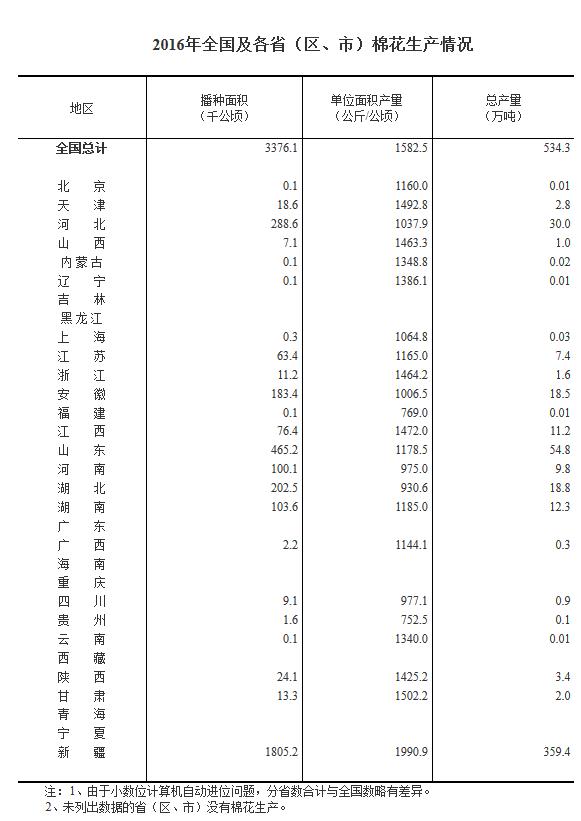CCTV News:According to the website of the National Bureau of Statistics, the total cotton output in 2016 was 5.343 million tons, a decrease of 260,000 tons or 4.6% compared with 2015.
According to the statistical survey of 31 provinces (autonomous regions and municipalities) in China (the cotton planting area in Xinjiang is obtained by remote sensing measurement), the cotton planting area, yield per unit area and total output in 2016 are as follows:
1. The cotton planting area in China is 3376.1 thousand hectares (50.642 million mu), a decrease of 4.205 thousand hectares (6.308 million mu) or 11.1% compared with 2015.
Second, the national cotton output per unit area was 1582.5 kg/ha (105.5 kg/mu), an increase of 106.5 kg/ha (7.1 kg/mu) or 7.2% compared with 2015.
3. The total cotton output in China was 5.343 million tons, a decrease of 260,000 tons or 4.6% compared with 2015.

Explanation on the system and method of cotton yield survey
The total cotton output in China is the sum of cotton in 31 provinces (autonomous regions and municipalities).
(A) survey methods
The statistical survey of cotton yield adopts the method of combining remote sensing measurement, sampling survey and comprehensive statistics of non-main producing areas, and the survey targets include plots, agricultural production and business households and business units. Xinjiang obtains the area by remote sensing measurement and the yield by sampling survey; Hebei, Jiangsu, Anhui, Shandong, Henan, Hubei, and Hunan cotton are collected by the survey corps sent by the National Bureau of Statistics, and other provinces (autonomous regions and municipalities) statistical bureaus obtain cotton area and yield data through comprehensive statistics.
Seven major cotton producing areas (excluding Xinjiang) were sampled by agricultural producers and business households. The survey was carried out by representative villagers’ groups, farmers and plots selected by the province as a whole. The survey of planting area was to investigate all cotton planting areas in the sample points at the survey time and calculate the actual planting area of cotton. The yield per unit area survey adopts the methods of field measurement and household visit to calculate the yield per unit area. Multiply the area by the yield to get the total yield.
Since 2014, the National Bureau of Statistics has carried out cotton remote sensing survey in Xinjiang. Through the combination of high and medium spatial resolution multi-temporal satellite remote sensing images and ground sampling survey, the cotton planting area on agricultural land in the whole region was measured. The area obtained through cotton remote sensing measurement and sampling survey accounts for more than 95% of the total cotton planting area in China.
(2) Survey samples
The field survey of cotton remote sensing measurement in Xinjiang includes more than 2,130 samples with a total of nearly 290,000 mu of survey plots. Seven cotton sampling survey provinces carried out surveys in 138 national survey counties, and more than 700 villagers’ groups and more than 80,000 farmers were selected in the cotton area survey. More than 700 villagers’ groups and more than 7,000 farmers were selected from the cotton yield per unit area survey, which was carried out by the investigators and auxiliary investigators of the grass-roots investigation teams of the National Bureau of Statistics. The remaining provinces (autonomous regions and municipalities) adopt a comprehensive statistical method and obtain data by reporting at different levels.
(3) Measurement method
According to the Statistical Report System of Agriculture, Forestry, Animal Husbandry and Fishery, the yield survey of main cotton varieties per unit area was obtained by field measurement and household yield measurement respectively.
The field survey was carried out in randomly selected area survey sample points. When the cotton maturity approached, the yield of all plots in the sample points was estimated, and five representative plots were selected as measured plots according to the yield level of plots by the way of area cumulative sorting and equidistant sampling. After the cotton is ripe, three small quadrats are selected manually on the spot, and the cotton yield per unit area is obtained by means of peach counting, weighing and loss verification.
Household yield measurement is carried out in randomly selected area survey sample points. When cotton maturity approaches, the yield of all households in the sample points is estimated, and the average yield level of each household is calculated according to the estimated yield. After cotton matures, 10 households are selected by the method of accumulating equidistant sampling according to the average yield of each household. After cotton picking, the cotton planting area, harvest, sales volume, storage volume and self-consumption of the surveyed households are registered at home. The investigation teams of the National Bureau of Statistics calculate the average unit area output of the whole province (autonomous regions and municipalities) according to the unit yield of the sampled plots.